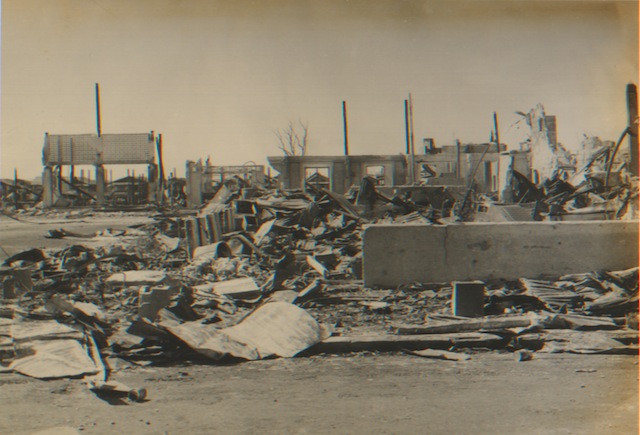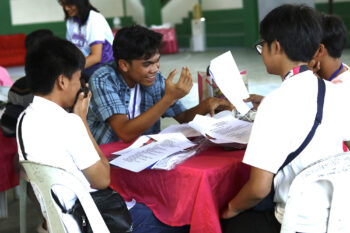(This piece was first published in mindanews.com on 7 February 2004, the 30th anniversary of the burning of Jolo and reprinted in the February 2011 issue of OUR Mindanao newsmagazine. We are reprinting this here on February 7, 2016, the 42nd anniversary of the burning of Jolo]
Who remembers February 7, 1974, the day the town of Jolo in Sulu burned?
Who remembers the long queue to get into a naval boat to escape the inferno? Or the rush to board whatever available boat there was, the fleeing refugees raising their babies whenever fighter pilots flew over them, if only to prove to the bombers above that they were non-combatants?
Who remembers how many thousands fled on small boats, reached Zamboanga or Sabah
and from there, longed for the day they could return home (until some of them eventually gave up hope of ever returning).
Helen Tan Garcia, who passed away a few years ago, gave me my first eyewitness account of the 1974 burning, 12 years later, during my first visit to Jolo. The length of time notwithstanding, her recollection remained vivid like it happened only yesterday.
She had just given birth two weeks earlier. A birthday cake was prepared evening of February 6 for a relative’s child who was going to celebrate his birthday the next day.
There would be no celebration. Years later, when they learned to laugh again, relatives would jokingly ask each other, “what happened to the birthday cake?”
There was much crying on the day Jolo burned. “It was a miracle we survived,” she recalled.
 Beth Studio used to stand in this area in Jolo, Sulu, in the aftermath of the February 7, 1974 burning of the town. Photo courtesy of the OMI Archives
Beth Studio used to stand in this area in Jolo, Sulu, in the aftermath of the February 7, 1974 burning of the town. Photo courtesy of the OMI Archives
It was the first time I heard someone describe a huge crowd as “like grasses.”
For, indeed, said Helen, the people who rushed to the provincial government hospital compound were so many. “We could not move an inch. I felt like all of us were like grasses. Everywhere was people.”
Helen also spoke of how thousands fought for space in the naval boats that would ferry them to safety. They waited for two days at the wharf convincing naval officials to allow them to board the boat. It helped that she had a two-week old baby.
Her sister, Carolyn Que, who was scheduled to give birth in March, gave birth in the naval boat evacuating them to Zamboanga. The baby was named Navalina after the naval boat, where she was born. Her birthplace? Between Jolo and Zamboanga.
Early dawn of February 7, 1974, residents of Jolo in Sulu woke up to the sound of gunfire. By afternoon, thousands of families had fled their homes, hundreds of bodies littered the streets and the sea.
The poblacion was “infernal,” a resident recalls, as houses and buildings went up in smoke, leaving only the town hall, the Catholic Church, the Islamic mosque, the provincial hospital and Jose Rizal’s statue at the plaza.
That day would be referred to in history as “the burning of Jolo” but who and what started the burning, is another story.
The military accused the Moro National Liberation Front of having started the fire, the MNLF said it was the military.
Perhaps we will never know.
Nur Jaafar, the man who succeeded in getting Nur Misuari to agree to talk again with government under the Ramos administration, was then provincial attorney of Tawi-tawi and was in Zamboanga City the day Jolo burned.
He recalls having begged naval officers to allow him to board the ship to Jolo where his family resided.
By the time he reached the port of Jolo, floating bloated bodies welcomed him. Walking towards the hospital to look for his wife and four children, Jaafar saw more bodies along the streets and dogs feasting on the corpses.
The stench of death and burnt flesh he cannot forget. Miraculously, his family survived but the youngest, then three months old, suffered the most. “My child became deaf on one ear.”
Tausug writer Said K. Sadain, Jr. refers to February 7, 1974 or The burning of Jolo as the “Jolo-caust.”
In his book, Bugs & Bytes (published in 1999 by the The Libenet Center), Sadain recalls he was a 15-year old senior high school student expecting to receive, the next month, his graduation diploma from the Dayang-Dayang Hadji Piandao Memorial High School, Boys Department.
“As it was, in the dark dawn of February 7, 1974, before our graduating class could even start practicing for our graduation rites, the tranquility of the municipality of Jolo was shattered by a loud explosion that was clearly heard from one end of town to the other. For the next three, four days, Jolo became embroiled in a shooting war, house to house, door to door, with the Moro National Liberation Front rebels, Lost Command as some MNLF apologists would later claim, initially marching into town to lay siege on the government army encampment at the towns airport.
“My family stayed in our San Raymundo house during most of the first two days of fighting, except for some uncles who ventured out into the streets to get some drinking water.
“It seemed that most of the fighting was happening elsewhere, like a television war movie that one was not particularly paying attention to. Of course, there were no TV sets in Jolo at that time. This kind of realization came much later along with other realizations, as these things normally do.
“In the afternoon of the second day, everything else around the neighborhood broke loose, with mortars and gunfire screaming. From a high window at the back of the house, I watched the brittle nipa-thatch roofs of nearby houses catch the fireballs whooshing down from the sky.
“When it was all over, the only thing that remained of our house was the front stairs leading up to a charred front door that opened up to clear, blue sky.”
UP Professor Mashour Jundam was in Manila on a one-year research training and rushed to volunteer to the Red Cross so he could get to Jolo where his wife and three young daughters lived.
It took him a week to get to Jolo. His family survived but a number of his relatives didn’t, including a cousin of his wife whose entire family was killed in a grenade explosion.
Dr. Abas Candao of Maguindanao, a UP College of Medicine graduate, Batch 1971, wrote a journal of those days while assigned at the Sulu provincial hospital in Jolo.
“The fire which started about three o’clock in the afternoon from the eastern sector was blown into town by strong southeasterly winds leaving behind its path nothing but scrap and ashes as it devoured its way through, swallowing the business sector and rapidly spreading towards Asturias. The heinous column of fire and smoke mushroomed high into the air sending out fiery tongues and swaying ominously to where the wind would lead it. It was a dreadful sight in the night, providing its own light for its horror performance. Silently, their eyes moist with tears, providing its own light for its horror performance.
“At the hospital, the understaffed personnel worked, day and night. And there was something eerie about what was taking place. Under the flickering light of our candles, the sight of the amputated limbs scattered all around us, the dead bathed in their own blood, the moaning of the wounded and the slow tum-tum of a distant drum created an atmosphere that would make one’s hair stand on end.”
Before the burning, Jolo was the “little cup of silver,” a cosmopolitan area with movie houses and hotels. Zamboanga City was nothing compared with Jolo.
Oswalda Cabel, a councilor of Jolo for 20 years and 71 at the time of the interview in 1994, described that day as infernal.
“You could compare it only to the liberation of Jolo in 1945 and although the area covered by the destruction was a little less than in 1945, there was so much fire.”
Cabel recalled that before the burning, Jolo was a peaceful and progressive town.
But 1974’s mass exodus brought about so much loss for Jolo and so much gain for Zamboanga as an estimated 48,000 residents who fled to Zamboanga settled there.
In 1974, Jolo’s population was estimated at 100,000.
It is not clear how many thousands fled to Sabah.
“When you have a mass exodus like that big a number, with their departure, they carry with them their expertise, their capital, their technical knowhow,” Cascabel said.
“From 1974 onwards, downhill na. Walang progress, walang recovery. Jolo has since been trying to recover. But the infrastructure you see now, wala yan compared to before: We had better buildings, better homes,” she said.
Before the burning of Jolo, she and her husband and children would watch late night movies at 9, leave the moviehouse at 11, buy hot pandesal and eat them at Plaza Rizal. There were night markets and residents even went night swimming at Quezon Beach.
Many of those who fled to Zamboanga City and Sabah never returned. Helen Tan Garcia did.
But Jolo and the province of Sulu was never the same again. (Carolyn O. Arguillas/MindaNews. This piece was first published in mindanews.com on 7 February 2004, the 30th anniversary of the burning of Jolo. The concluding sentence was “Thirty years later, Jolo has yet to rise from the ashes.” February 7, 2016 is the 42nd anniversary of the burning of Jolo).
